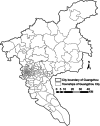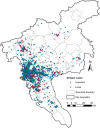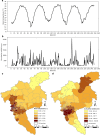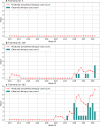Facilitating fine-grained intra-urban dengue forecasting by integrating urban environments measured from street-view images
- PMID: 33766145
- PMCID: PMC7992840
- DOI: 10.1186/s40249-021-00824-5
Facilitating fine-grained intra-urban dengue forecasting by integrating urban environments measured from street-view images
Abstract
Background: Dengue fever (DF) is a mosquito-borne infectious disease that has threatened tropical and subtropical regions in recent decades. An early and targeted warning of a dengue epidemic is important for vector control. Current studies have primarily determined weather conditions to be the main factor for dengue forecasting, thereby neglecting that environmental suitability for mosquito breeding is also an important factor, especially in fine-grained intra-urban settings. Considering that street-view images are promising for depicting physical environments, this study proposes a framework for facilitating fine-grained intra-urban dengue forecasting by integrating the urban environments measured from street-view images.
Methods: The dengue epidemic that occurred in 167 townships of Guangzhou City, China, between 2015 and 2019 was taken as a study case. First, feature vectors of street-view images acquired inside each township were extracted by a pre-trained convolutional neural network, and then aggregated as an environmental feature vector of the township. Thus, townships with similar physical settings would exhibit similar environmental features. Second, the environmental feature vector is combined with commonly used features (e.g., temperature, rainfall, and past case count) as inputs to machine-learning models for weekly dengue forecasting.
Results: The performance of machine-learning forecasting models (i.e., MLP and SVM) integrated with and without environmental features were compared. This indicates that models integrating environmental features can identify high-risk urban units across the city more precisely than those using common features alone. In addition, the top 30% of high-risk townships predicted by our proposed methods can capture approximately 50-60% of dengue cases across the city.
Conclusions: Incorporating local environments measured from street view images is effective in facilitating fine-grained intra-urban dengue forecasting, which is beneficial for conducting spatially precise dengue prevention and control.
Keywords: Dengue forecasting; Fine-grained; Intra-urban; Street-view image; Urban environment.
Conflict of interest statement
The authors declare no competing interests.
Figures















Similar articles
-
Enhancing fine-grained intra-urban dengue forecasting by integrating spatial interactions of human movements between urban regions.PLoS Negl Trop Dis. 2020 Dec 21;14(12):e0008924. doi: 10.1371/journal.pntd.0008924. eCollection 2020 Dec. PLoS Negl Trop Dis. 2020. PMID: 33347463 Free PMC article.
-
Added-value of mosquito vector breeding sites from street view images in the risk mapping of dengue incidence in Thailand.PLoS Negl Trop Dis. 2021 Mar 8;15(3):e0009122. doi: 10.1371/journal.pntd.0009122. eCollection 2021 Mar. PLoS Negl Trop Dis. 2021. PMID: 33684130 Free PMC article.
-
Developing a Time Series Predictive Model for Dengue in Zhongshan, China Based on Weather and Guangzhou Dengue Surveillance Data.PLoS Negl Trop Dis. 2016 Feb 19;10(2):e0004473. doi: 10.1371/journal.pntd.0004473. eCollection 2016 Feb. PLoS Negl Trop Dis. 2016. PMID: 26894570 Free PMC article.
-
Urban climate versus global climate change-what makes the difference for dengue?Ann N Y Acad Sci. 2016 Oct;1382(1):56-72. doi: 10.1111/nyas.13084. Epub 2016 May 19. Ann N Y Acad Sci. 2016. PMID: 27197685 Review.
-
Modeling and projection of dengue fever cases in Guangzhou based on variation of weather factors.Sci Total Environ. 2017 Dec 15;605-606:867-873. doi: 10.1016/j.scitotenv.2017.06.181. Epub 2017 Jul 3. Sci Total Environ. 2017. PMID: 28683431 Review.
Cited by
-
Forecasting Dengue Hotspots Associated With Variation in Meteorological Parameters Using Regression and Time Series Models.Front Public Health. 2021 Nov 26;9:798034. doi: 10.3389/fpubh.2021.798034. eCollection 2021. Front Public Health. 2021. PMID: 34900929 Free PMC article.
-
A systematic review of the data, methods and environmental covariates used to map Aedes-borne arbovirus transmission risk.BMC Infect Dis. 2023 Oct 20;23(1):708. doi: 10.1186/s12879-023-08717-8. BMC Infect Dis. 2023. PMID: 37864153 Free PMC article.
-
Short-term effects of tropical cyclones on the incidence of dengue: a time-series study in Guangzhou, China.Parasit Vectors. 2022 Oct 6;15(1):358. doi: 10.1186/s13071-022-05486-2. Parasit Vectors. 2022. PMID: 36203178 Free PMC article.
-
Automatic mapping of high-risk urban areas for Aedes aegypti infestation based on building facade image analysis.PLoS Negl Trop Dis. 2024 Jun 3;18(6):e0011811. doi: 10.1371/journal.pntd.0011811. eCollection 2024 Jun. PLoS Negl Trop Dis. 2024. PMID: 38829905 Free PMC article.
-
The practicality of Malaysia dengue outbreak forecasting model as an early warning system.Infect Dis Model. 2022 Aug 8;7(3):510-525. doi: 10.1016/j.idm.2022.07.008. eCollection 2022 Sep. Infect Dis Model. 2022. PMID: 36091345 Free PMC article.
References
MeSH terms
Grants and funding
LinkOut - more resources
Full Text Sources
Other Literature Sources
Medical
Miscellaneous

